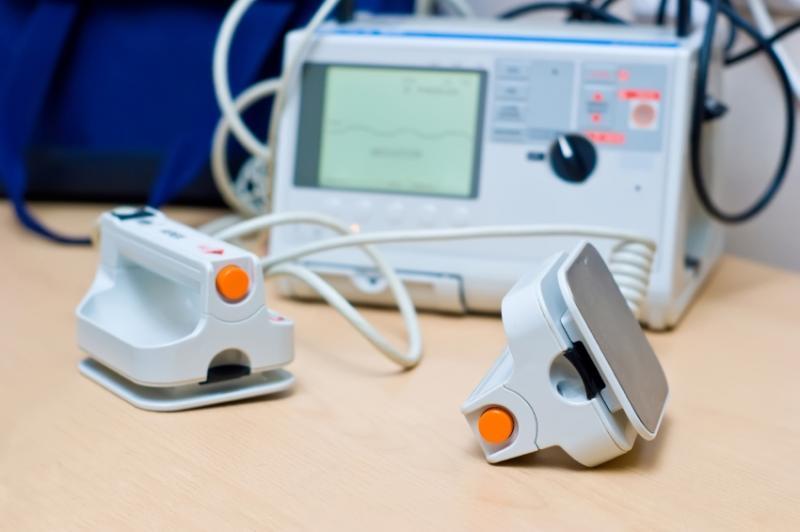Public Access Defibrillation
Regulation Update for AED
On September 3, 2015 SB 658 was signed into law, reducing liability conditions on a person or entities that acquire and place an AED. As a result, Chapter 1.8, Div. 9, Title of 22 of the California Code of Regulations is now repealed.
Under the revised statute, a person or entity that acquires an AED for emergency use is not liable for civil damages resulting from use of an AED to provide emergency medical care so long as the person or entity does the following:
- Comply with all regulations governing the placement of an AED.
- Notify an agent of the local EMS agency of the existence, location, and type of AED acquired.
- Ensure that the AED is maintained and tested according to the operation and maintenance guidelines set forth by the manufacturer.
- Ensure that the AED is tested at least twice annually and after each use.
- Ensure that an inspection is made of all AEDs on the premises at least every 90 days for potential issues related to operability of the device, including a blinking light or other obvious defect that may suggest tampering or that another problem has arisen with the functionality of the AED.
- Ensure that records of the maintenance and testing as required by Section 1797.196 of the Health and Safety Code are maintained.
- Notify EMS agency within 24 hours of AED use.
- Next to the AED, post instructions, in no less than 14-point type, on how to use the AED.
No longer required:
- A medical director or other physician involvement in the acquisition or placement of an AED.
- CPR certification and AED training of at least one employee during business hours.
- Designated employee(s) trained to respond to emergencies during business hours.
New Rules for Schools
SB 658 modifies requirements concerning placement of AEDs in public and private K-12 schools:
- School administrators and staff shall receive information that on sudden cardiac arrest, the school’s emergency response plan, and the proper use of an AED at least once annually.
- Instructions on how to use an AED shall posted next to every AED. Instructions must be in no less than 14-point font.
- School employees shall be notified of the location of all AEDs on campus at least once annually.
- The statute does not prohibit a school employee or other person from rendering aid with an AED.
No longer required:
- Requirement that principals designate trained employees who can respond to an emergency during normal business hours.
New Rules for Businesses
- At least once a year, notify the tenants as to the location of the AED units and provide information to tenants about who they can contact if they want to voluntarily take AED or CPR training.
- At least once a year, offer a demonstration to at least one person associated with the building so that the person can be walked through how to use an AED properly in an emergency.
- Post instructions on how to use the AED next to the AED in no less than 14-point font.
General Information
A defibrillator is used to “restart” the heart following cardiac arrest. These machines have been used in hospitals since the 1960s and outside the hospital by emergency medical responders since the 1970s. Sudden cardiac arrest is usually the result of erratic electrical activity within the heart muscle causing the heart to quiver no blood to be pumped. Cardiopulmonary resuscitation (CPR) can restore some blood flow but it is essential that an electrical shock be delivered to the heart (defibrillation) in order to restore an effective heart rhythm.
Defibrillation FAQ
Q: Why is defibrillation important?
A: The sooner defibrillation occurs, the better
the chance of the patient’s survival. Survival rates decrease
approximately 10% with every minute the patient remains in
cardiac arrest. Over the last decade automatic external
defibrillators (AEDs) have become available. These machines are
small, easily operated by a trained lay person, and have become
increasingly affordable.
The San Mateo County Emergency Medical Services (EMS) Agency encourages the placement of Automatic External Defibrillators (AED) in the community. Shopping centers, office buildings, golf courses, movie theaters, community centers, and school campuses are just a few examples of where AEDs may be located.
Q: Where can I learn how to operate an Automatic External
Defibrillator (AED)?
A: Training programs should meet the standards
of the American Heart Association or American Red Cross. Contact
these two organizations for information about training programs.
There are many courses available within the community. Most of
the courses are four hours in length and will include CPR and
AED.
Q: Where can I purchase an AED?
A: There are many vendors of AEDs. Please visit The
American Heart Association website for more information.
Q Are there any state or local requirements for public
access defibrillation?
A: California law requires that the purchaser of
an AED notify the local EMS Agency. This is so that we will know
where AEDs are placed within the community. You can complete the
form by downloading it (PAD Notification Form) and emailing it to us at
gfahey@smcgov.org.
State laws governing AEDs:
- Senate Bill No. 658, Automated external defibrillators
- Assembly Bill No. 1719, Pupil instruction: cardiopulmonary resuscitation
AED Forms
- AED User/Site Coor. Checklist
- PAD Notification Form
- Health Club Automatic External Defibrillation (AED) Use Report (NEW - 2/2015)
- Law Enforcement Automatic External Defibrillation (AED) Use Report (NEW - 2/2015)
- Public Access Automatic External Defibrillation (AED) Use Report (NEW - 2/2015)
- Public Safety Provider Agency Automatic External Defibrillation (AED) Use Report (NEW - 2/2015)
- CA EMS Authority - Regulation Repeal Memo
